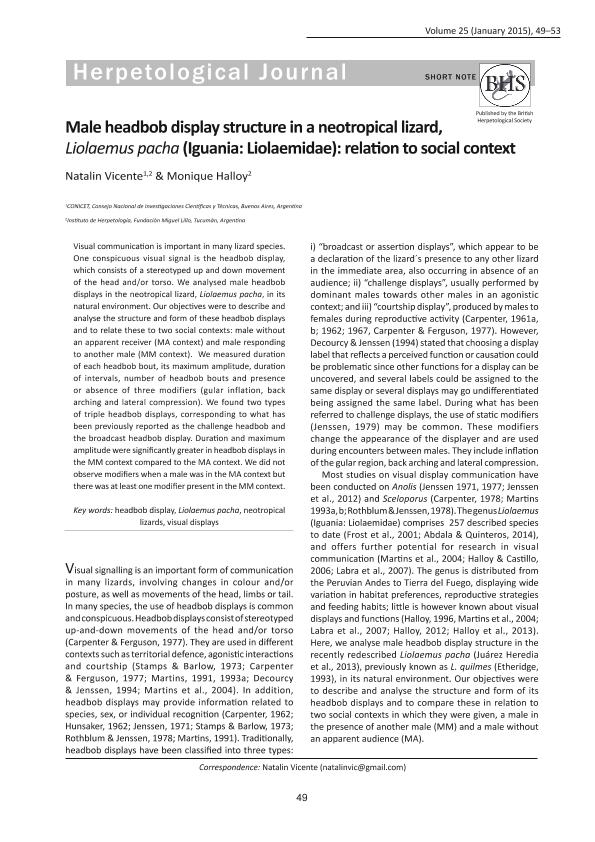Artículo
Male headbob display structure in a neotropical lizard, Liolaemus pacha (Iguania: Liolaemidae): relation to social context
Fecha de publicación:
02/2015
Editorial:
British Herpetological Society
Revista:
Herpetological Journal
ISSN:
0268-0130
Idioma:
Inglés
Tipo de recurso:
Artículo publicado
Clasificación temática:
Resumen
Visual communication is important in many lizard species. One conspicuous visual signal is the headbob display, which consists in a stereotyped up and down movement of the head and/or torso. We analysed male headbob displays in the neotropical lizard, Liolaemus pacha, in its natural environment. Our objectives were to describe and analyse the structure and form of these headbob displays and to relate these to two social contexts: male without an apparent receiver (MA context) and male responding to another male (MM context). We calculated duration of each headbob bout, its maximum amplitude, duration of intervals, number of headbob bouts and presence or absence of three modifiers (gular inflation, back arching and lateral compression). We performed linear mixed-effects models (LMMs) to compare maximum amplitude and duration of headbob bouts and intervals between contexts. To compare the number of headbob bouts per headbob display between contexts, we conducted a Mann-Whitney test. We found two types of headbob displays, both characterized by triple headbob bouts. We found that duration and maximum amplitude were significantly greater in headbob displays given in the MM context compared to those given in the MA context. We did not observe modifiers when a male was in the MA context but there was at least one modifier present in the MM context. Based on these results, we found that males of L. pacha presented two headbob displays related to two different social contexts which correspond to what has been reported in the literature as the challenge headbob display, performed in MM contexts, and the broadcast headbob display, performed in MA contexts.
Palabras clave:
HEADBOB DISPLAY
,
LIOLAEMUS PACHA
,
NEOTROPICAL LIZARD
,
VISUAL DISPLAYS
Archivos asociados
Licencia
Identificadores
Colecciones
Articulos(UEL)
Articulos de UNIDAD EJECUTORA LILLO
Articulos de UNIDAD EJECUTORA LILLO
Citación
Vicente, Natalin Soledad; Halloy, Monique; Male headbob display structure in a neotropical lizard, Liolaemus pacha (Iguania: Liolaemidae): relation to social context; British Herpetological Society; Herpetological Journal; 25; 1; 2-2015; 49-53
Compartir




